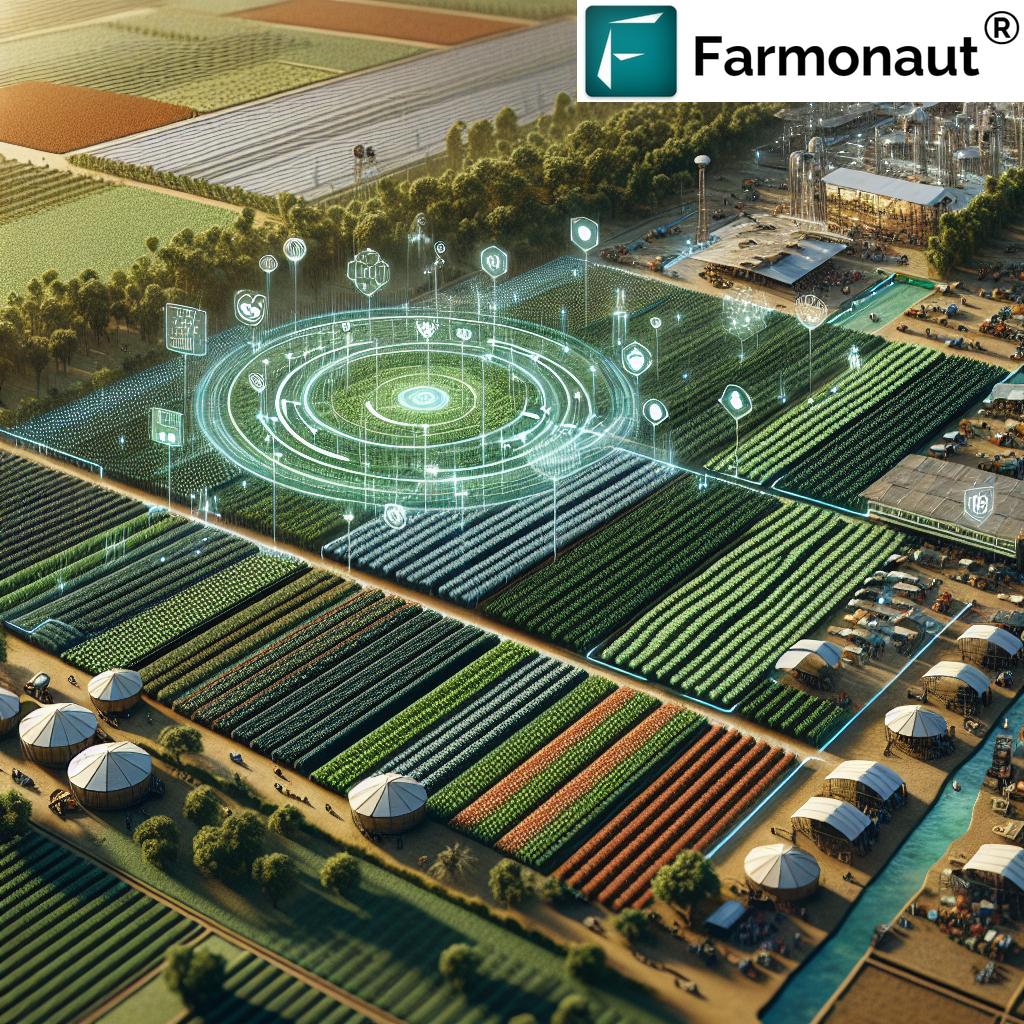Revolutionizing India’s Agriculture: How Digital Marketplaces and Real-Time Data Are Empowering Farmers
“Agmarknet, a government initiative, provides real-time data on arrivals, exports, and price trends for over 300 agricultural commodities across India.”
In the heart of India’s agricultural landscape, a digital revolution is unfolding. As we delve into the transformative world of digital agriculture marketing and online agricultural marketplaces, we witness firsthand how technology is reshaping the future of farming in our nation. From the bustling mandis of Punjab to the verdant fields of Maharashtra, farmers are embracing a new era of connectivity and information access that promises to revolutionize their livelihoods.
In this comprehensive exploration, we’ll uncover how real-time crop prices and agri commodity trading apps are putting the power of market intelligence directly into the hands of our farmers. We’ll examine government initiatives like Agmarknet that are bridging the information gap, providing crucial data on arrivals, exports, and price trends for a wide array of commodities including rice, dal, and vegetables.

The Digital Agriculture Revolution in India
The agricultural sector in India is undergoing a profound transformation, driven by the adoption of digital technologies and innovative marketing solutions. This shift is not just about modernization; it’s about empowerment, efficiency, and sustainability. Let’s explore the key aspects of this revolution:
- Real-Time Market Information: Farmers now have access to up-to-the-minute data on crop prices, demand, and market trends.
- Expanded Market Access: Digital platforms are connecting farmers directly to buyers, eliminating intermediaries and increasing profit margins.
- Data-Driven Decision Making: With access to historical data and predictive analytics, farmers can make informed choices about crop selection and timing.
- Streamlined Supply Chains: Digital marketplaces are optimizing the movement of produce from farm to table, reducing waste and improving freshness.
As we navigate through this digital landscape, it’s crucial to understand how these advancements are impacting every aspect of the agricultural value chain, from seed selection to harvest sales.
The Rise of Digital Agricultural Marketplaces
Digital agricultural marketplaces are at the forefront of this revolution, providing platforms where farmers, buyers, and other stakeholders can interact seamlessly. These online spaces are more than just trading platforms; they’re ecosystems that foster transparency, efficiency, and fair pricing.
Key features of these marketplaces include:
- Price Discovery: Real-time pricing information across different markets
- Direct Farmer-Buyer Connections: Cutting out middlemen and increasing farmer profits
- Quality Assurance: Standardized grading systems to ensure product quality
- Logistics Support: Integrated transportation and storage solutions
- Financial Services: Access to credit and insurance products
One of the pioneering initiatives in this space is Agmarknet, a government-backed portal that provides comprehensive market information. Let’s take a closer look at how Agmarknet and similar platforms are changing the game for Indian farmers.
Agmarknet: A Game-Changer in Agricultural Information
Agmarknet, short for Agricultural Marketing Information Network, is a flagship project of the Ministry of Agriculture and Farmers Welfare. This platform serves as a one-stop-shop for agricultural market information, covering a wide range of commodities including:
- Rice (Chawal)
- Dal (Pulses)
- Vegetables (Sabzi)
- Fruits (Phal)
- Oilseeds (Tel Beej)
- Spices (Masale)
By providing real-time data on arrivals, prices, and trends, Agmarknet empowers farmers to make informed decisions about when and where to sell their produce. This transparency helps in reducing price volatility and ensures fairer returns for farmers.
Access the Farmonaut Web App for advanced agricultural insights: 
Real-Time Crop Prices: A New Era of Market Intelligence
The availability of real-time crop prices is perhaps one of the most significant advancements in digital agriculture marketing. This information, once the privilege of large traders and middlemen, is now accessible to even the smallest farmers through their smartphones.
Benefits of real-time pricing include:
- Better Negotiation Power: Farmers can negotiate from a position of knowledge
- Optimal Timing of Sales: Ability to hold or sell based on price trends
- Reduced Information Asymmetry: Leveling the playing field between farmers and buyers
- Market Trend Analysis: Understanding long-term price movements for strategic planning
Apps and platforms offering real-time crop prices are becoming increasingly sophisticated, often integrating additional features like weather forecasts, pest alerts, and crop advisory services.
Case Study: Mandi Prices in Punjab
In Punjab, the heart of India’s wheat and rice production, digital platforms have transformed how farmers interact with mandis (agricultural markets). Farmers in cities like Jalandhar, Amritsar, and Ludhiana now regularly check online platforms for mandi prices before deciding where to sell their produce.
For instance, a wheat farmer in Mansa can compare prices across different mandis like Talwandi Sabo, Bhikhiwind, and Rampuraphul, choosing the most profitable option. This level of market visibility was unimaginable just a decade ago.
Agri Commodity Trading Apps: Putting Markets in Farmers’ Pockets
Agri commodity trading apps are taking the concept of digital marketplaces a step further by allowing farmers to not just view prices but also engage in transactions directly from their mobile devices. These apps are becoming increasingly popular, especially among younger, tech-savvy farmers.
Key features of these apps include:
- Live Trading: Ability to buy and sell commodities in real-time
- Price Alerts: Notifications when prices reach preset thresholds
- Market Analysis Tools: Charts and reports to help understand market trends
- Virtual Wallets: Secure payment systems for transactions
- Educational Resources: Information on trading strategies and market dynamics
These apps are not just changing how farmers sell their produce; they’re also opening up new opportunities for smallholder farmers to participate in futures and options trading, previously the domain of large agribusinesses.
“Digital agriculture marketplaces have connected over 10 million smallholder farmers in India to broader markets, increasing their average income by 15%.”
Empowering Smallholder Farmers Through Digital Tools
Smallholder farmers, who form the backbone of Indian agriculture, are perhaps the biggest beneficiaries of this digital revolution. With limited resources and traditionally restricted access to markets, these farmers are now finding new avenues for growth and profitability.
Digital tools are empowering smallholder farmers in several ways:
- Market Access: Connecting to buyers beyond local markets
- Collective Bargaining: Forming digital cooperatives for better pricing
- Financial Inclusion: Access to digital banking and micro-credit services
- Knowledge Sharing: Peer-to-peer learning through online communities
- Risk Management: Weather alerts and crop insurance through mobile apps
For instance, a small vegetable farmer in Visakhapatnam can now sell their produce directly to buyers in Hyderabad or even Mumbai, thanks to digital marketplaces. This expanded reach not only increases their potential customer base but also reduces their dependency on local intermediaries.

Sustainable Agriculture Practices and the Digital Supply Chain
The digital revolution in agriculture is not just about marketing and sales; it’s also driving sustainable farming practices. As consumers become more conscious about the origin and production methods of their food, digital platforms are facilitating transparency and traceability in the agricultural supply chain.
Key aspects of sustainable agriculture supported by digital tools include:
- Precision Farming: Using data to optimize resource use
- Crop Rotation Planning: AI-driven recommendations for sustainable land use
- Water Management: Smart irrigation systems controlled via mobile apps
- Organic Certification: Digital tracking of organic farming practices
- Carbon Footprint Reduction: Monitoring and reducing emissions in the supply chain
Digital platforms are also enabling the creation of shorter, more efficient supply chains. By connecting farmers directly with consumers or retailers, these platforms are reducing food miles and ensuring fresher produce reaches the end consumer.
Explore Farmonaut’s API for advanced agricultural data: Farmonaut API
Case Study: Digital Traceability in Maharashtra’s Fruit Exports
In Maharashtra, known for its export-quality mangoes and grapes, digital traceability systems are revolutionizing the fruit export business. Farmers in regions like Junnar and Jalgaon are using blockchain-based apps to record every step of their production process, from planting to harvesting.
This digital trail allows exporters and international buyers to verify the quality and origin of the fruits, ensuring compliance with international standards and fetching premium prices for farmers.
The Transformation of Agricultural Marketing Systems
The traditional agricultural marketing system in India, characterized by multiple intermediaries and opaque pricing mechanisms, is undergoing a significant transformation. Digital platforms are streamlining the process, making it more efficient and transparent.
Key changes in the agricultural marketing system include:
- Direct Farmer-Consumer Connections: Reducing the number of intermediaries
- Online Auctions: Replacing physical auctions with digital bidding systems
- Quality Standardization: Digital grading and certification processes
- Inventory Management: Real-time tracking of stock levels across warehouses
- Demand Forecasting: Using big data to predict market needs
This transformation is evident across various states, each adapting digital solutions to their unique agricultural landscapes:
- Punjab: Digital management of wheat and rice procurement
- Gujarat: Online trading platforms for cotton and groundnuts
- Maharashtra: Digital marketplaces for horticultural products
The Role of e-NAM (Electronic National Agriculture Market)
A significant initiative in this transformation is e-NAM, a pan-India electronic trading portal that networks existing APMC (Agricultural Produce Market Committee) mandis to create a unified national market for agricultural commodities. e-NAM is revolutionizing agricultural trading by:
- Providing a single window service for all APMC related information and services
- Promoting real-time price discovery based on actual demand and supply
- Enabling smoother transactions and reducing transaction costs
- Facilitating better price realization for farmers
The success of e-NAM demonstrates the potential of digital platforms in transforming traditional agricultural marketing systems.
Access Farmonaut’s Developer Documentation: API Developer Docs
The Future of Farming: Data-Driven Approaches and Mobile Technology
As we look to the future, it’s clear that data-driven approaches and mobile technology will continue to play a pivotal role in shaping Indian agriculture. The convergence of various technologies is creating a smart farming ecosystem that promises to make agriculture more precise, productive, and sustainable.
Key trends shaping the future of farming include:
- IoT in Agriculture: Sensor-based monitoring of crops and livestock
- AI-Powered Decision Support: Advanced analytics for farm management
- Drone Technology: For crop mapping, spraying, and monitoring
- Blockchain in Supply Chain: Ensuring transparency and traceability
- 5G Connectivity: Enabling real-time data transfer and remote operations
Mobile technology, in particular, is bridging the digital divide, bringing the power of these advanced technologies to even the most remote farming communities. From simple SMS-based advisory services to sophisticated farm management apps, mobile phones are becoming the primary tool for farmers to access information, markets, and services.
Impact on the Agricultural Economy and Farmer Livelihoods
The digital revolution in agriculture is having a profound impact on India’s agricultural economy and the livelihoods of millions of farmers. Some key impacts include:
- Increased Farm Incomes: Better price realization and reduced input costs
- Improved Market Efficiency: Reduction in post-harvest losses and better supply-demand matching
- Enhanced Food Security: Better crop planning and distribution
- Rural Employment Generation: New opportunities in agri-tech and related services
- Attracting Youth to Agriculture: Making farming more appealing to younger generations
These changes are not just improving individual farmer incomes but are also contributing to the overall growth and modernization of India’s agricultural sector.
Case Study: Digital Transformation in Gujarat’s Cotton Belt
In Gujarat’s cotton-growing regions like Ahmedabad and Anand, digital platforms have transformed how cotton is traded. Farmers now use mobile apps to check cotton prices across different markets, from local gin yards to international commodity exchanges.
This access to information has empowered farmers to time their sales better and negotiate fair prices. Additionally, digital quality assessment tools have made the grading process more transparent, ensuring that farmers get paid according to the true quality of their cotton.
Get Farmonaut on your mobile device:
Challenges and the Road Ahead
While the digital revolution in Indian agriculture holds immense promise, it’s not without its challenges. Some key issues that need to be addressed include:
- Digital Literacy: Ensuring farmers can effectively use digital tools
- Infrastructure: Improving internet connectivity in rural areas
- Data Privacy: Protecting farmers’ data and ensuring its responsible use
- Inclusivity: Ensuring small and marginal farmers are not left behind
- Integration: Harmonizing various digital platforms and initiatives
Addressing these challenges will require concerted efforts from the government, private sector, and civil society organizations. Initiatives like Digital India and Skill India have a crucial role to play in building the necessary digital infrastructure and capabilities.
Digital Agriculture Marketplace Comparison
| Platform Name | Key Features | Commodities Covered | Geographic Reach | Real-Time Price Updates | User Base (Estimated) | Government Integration |
|---|---|---|---|---|---|---|
| Agmarknet | Comprehensive market data, Price forecasting | 300+ agricultural commodities | Pan-India | Yes | 5 million+ | Fully integrated |
| e-NAM | Online trading, Quality assaying | 150+ commodities | 1000+ mandis across India | Yes | 1.6 million farmers | Government initiative |
| AgroStar | Advisory services, Input procurement | Major crops | Maharashtra, Gujarat, Rajasthan | Partial | 5 million+ | Partial |
| Ninjacart | Supply chain optimization, Direct farmer-retailer connect | Fruits and vegetables | Major cities | Yes | 200,000+ farmers | No direct integration |
| ITC e-Choupal | Price discovery, Weather information | Soya, wheat, coffee, rice | 10 states | Yes | 4 million farmers | Partial |
Conclusion: A New Era for Indian Agriculture
The digital revolution in Indian agriculture marks the beginning of a new era, one where information, technology, and market access converge to empower farmers like never before. From the bustling mandis of Punjab to the coconut groves of Kerala, digital tools are reshaping how farmers cultivate, market, and sell their produce.
As we’ve explored in this blog, real-time crop prices, agri commodity trading apps, and initiatives like Agmarknet are not just technological advancements; they’re catalysts for social and economic change in rural India. They’re enabling smallholder farmers to access broader markets, make informed decisions, and ultimately, improve their livelihoods.
The journey towards a fully digitized agricultural ecosystem is still ongoing, with challenges to overcome and opportunities to seize. However, the foundations laid by current initiatives promise a future where Indian agriculture is more efficient, sustainable, and profitable.
As we look ahead, it’s clear that the continued integration of digital technologies in agriculture will play a crucial role in ensuring food security, improving farmer incomes, and positioning India as a global agricultural powerhouse. The digital revolution in agriculture is not just transforming farming; it’s sowing the seeds for a more prosperous and sustainable rural India.
FAQ Section
- What are digital agricultural marketplaces?
Digital agricultural marketplaces are online platforms that connect farmers directly with buyers, providing real-time price information, quality assurance, and often logistics support. They aim to eliminate intermediaries and improve price realization for farmers. - How do real-time crop prices benefit farmers?
Real-time crop prices give farmers up-to-date market information, allowing them to make informed decisions about when and where to sell their produce. This helps in getting better prices and reduces exploitation by middlemen. - What is Agmarknet?
Agmarknet is a government initiative that provides comprehensive market information on agricultural commodities. It offers real-time data on arrivals, prices, and trends for over 300 commodities across India. - How are smallholder farmers benefiting from digital tools?
Digital tools are helping smallholder farmers access broader markets, obtain better prices, access financial services, and gain knowledge about best farming practices. This is leading to increased incomes and improved livelihoods. - What role does mobile technology play in agricultural marketing?
Mobile technology serves as the primary interface for farmers to access digital marketplaces, check prices, receive weather updates, and connect with buyers. It’s bridging the digital divide and bringing advanced agricultural services to remote areas.








